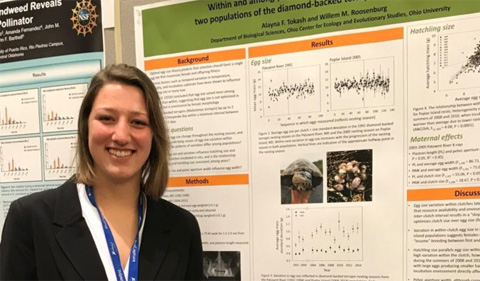Biology graduate student Alayna Tokash presented a poster on diamondback terrapin reproduction at the annual Society for Integrative and Comparative Biology meeting in San Francisco in January.
Her poster was titled “Within and among year variation in reproductive output from two populations of the diamond-backed terrapin, Malaclemys terrapin.” Tokash is a graduate student in the Biological Sciences program in Dr. Willem Roosenburg’s lab. Roosenburg was included as a co-author on the poster.
Abstract: Optimal egg size theory predicts that selection should favor a single egg size that simultaneously maximizes female and offspring fitness. Deviations from an optimal egg size exist where extrinsic factors such as temporal variation in temperature, humidity, and incubation substrate have been shown to influence reproductive output in many taxa. We investigated variation in reproductive output between two populations of the Diamond-backed Terrapin, Malaclemys terrapin, in Maryland over multiple years. Data was acquired from excavated nests and gravid female X-rays in the Patuxent River and excavated nests from Poplar Island. In both populations females lay multiple clutches within a nesting season, and egg size within clutches varies little during the first half of the nesting season. However, within clutch egg size variation increases in subsequent clutches suggesting that resource availability and environmental stochasticity during the inter-clutch interval results in a “sloppy” allocation strategy where females switch from “capital” to “income” breeding between first and subsequent clutches respectively. Female size and pelvic aperture width correlated weakly with egg width in the Patuxent River. Poplar Island egg and hatchling metric comparisons indicate there is a strong relationship between egg and hatchling size, and within clutch variation in egg size was mirrored in variation in hatchling size. Our findings suggest that egg size is not constrained by female morphology and appears to be optimized for female over offspring fitness by maximizing the number of offspring as resources allow. We also suggest that variation in egg size is influenced by either environmental variation or resource availability during inter-clutch periods.




















Comments